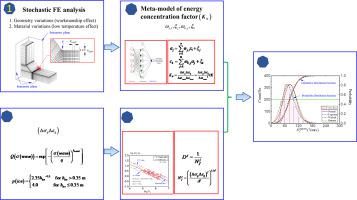当前位置:
X-MOL 学术
›
J. Constr. Steel Res.
›
论文详情
Our official English website, www.x-mol.net, welcomes your
feedback! (Note: you will need to create a separate account there.)
Probabilistic fatigue life of welded plate joints under uncertainty in Arctic areas
Journal of Constructional Steel Research ( IF 4.0 ) Pub Date : 2021-01-01 , DOI: 10.1016/j.jcsr.2020.106412 Liuyang Feng , Limao Zhang , Xiaowei Liao , Wei Zhang
Journal of Constructional Steel Research ( IF 4.0 ) Pub Date : 2021-01-01 , DOI: 10.1016/j.jcsr.2020.106412 Liuyang Feng , Limao Zhang , Xiaowei Liao , Wei Zhang

|
Abstract This paper develops a new practical framework of high-cycle fatigue (HCF) probability analysis of local welded plate joints considering the uncertainty in Arctic areas. The framework includes 1) a meta-model of the local energy concentration factor relying on the genetic algorithm and neural network (GA-NN) approach, 2) the identification of uncertainties in the fatigue assessment procedure, and 3) the probability analysis relying on the Monte Carlo simulation with Latin hypercube sampling method. The GA-NN determines the interactive relationship among the geometrical properties for a good estimation of the energy-based indicator concentration factor. The probability analysis considers the uncertainty caused by the meat-model, the local welding geometry, the Young modulus under different temperatures, and the combination of the ice and wave loadings. To determine the uncertainties involved in probability analysis, this study conducts a series of experimental measurements and high-cycle fatigue tests of cruciform welded plate joints. Furthermore, this study discusses the effect of the ice loading, maximum wave stress, and main plate thickness of welded plate joints on the expected fatigue life. The additional ice loading on the welded plate joints can almost cut the expected fatigue life in 33% in comparison with that only under wave loadings, implying the necessity of considering ice loading in Arctic areas. This study also proposes a probability S-N curve with the cumulative probability of 50% based on the maximum local energy-based indicator to estimate the expected fatigue life.
中文翻译:

北极地区不确定条件下焊接板接头的概率疲劳寿命
摘要 考虑到北极地区的不确定性,本文开发了一种新的局部焊接板接头高周疲劳 (HCF) 概率分析实用框架。该框架包括 1) 依赖于遗传算法和神经网络 (GA-NN) 方法的局部能量集中因子的元模型,2) 疲劳评估程序中的不确定性识别,以及 3) 依赖于使用拉丁超立方体采样方法的蒙特卡罗模拟。GA-NN 确定几何属性之间的交互关系,以便对基于能量的指示剂浓度因子进行良好的估计。概率分析考虑了由肉模型、局部焊接几何形状、不同温度下的杨氏模量引起的不确定性,以及冰和波浪载荷的组合。为了确定概率分析中涉及的不确定性,本研究对十字形焊接板接头进行了一系列实验测量和高周疲劳试验。此外,本研究讨论了冰载荷、最大波应力和焊接板接头的主板厚度对预期疲劳寿命的影响。与仅在波浪载荷下相比,焊接板接头上的附加冰载荷几乎可以将预期疲劳寿命降低 33%,这意味着在北极地区考虑冰载荷的必要性。本研究还提出了基于最大局部能量为基础的指标累积概率为50%的概率SN曲线来估计预期疲劳寿命。为了确定概率分析中涉及的不确定性,本研究对十字形焊接板接头进行了一系列实验测量和高周疲劳试验。此外,本研究讨论了冰载荷、最大波应力和焊接板接头的主板厚度对预期疲劳寿命的影响。与仅在波浪载荷下相比,焊接板接头上的附加冰载荷几乎可以将预期疲劳寿命降低 33%,这意味着在北极地区考虑冰载荷的必要性。本研究还提出了基于最大局部能量指标的累积概率为50%的概率SN曲线来估计预期疲劳寿命。为了确定概率分析中涉及的不确定性,本研究对十字形焊接板接头进行了一系列实验测量和高周疲劳试验。此外,本研究讨论了冰载荷、最大波应力和焊接板接头的主板厚度对预期疲劳寿命的影响。与仅在波浪载荷下相比,焊接板接头上的附加冰载荷几乎可以将预期疲劳寿命降低 33%,这意味着在北极地区考虑冰载荷的必要性。本研究还提出了基于最大局部能量为基础的指标累积概率为50%的概率SN曲线来估计预期疲劳寿命。本研究对十字形焊接板接头进行了一系列实验测量和高周疲劳试验。此外,本研究讨论了冰载荷、最大波应力和焊接板接头的主板厚度对预期疲劳寿命的影响。与仅在波浪载荷下相比,焊接板接头上的附加冰载荷几乎可以将预期疲劳寿命降低 33%,这意味着在北极地区考虑冰载荷的必要性。本研究还提出了基于最大局部能量指标的累积概率为50%的概率SN曲线来估计预期疲劳寿命。本研究对十字形焊接板接头进行了一系列实验测量和高周疲劳试验。此外,本研究讨论了冰载荷、最大波应力和焊接板接头的主板厚度对预期疲劳寿命的影响。与仅在波浪载荷下相比,焊接板接头上的附加冰载荷几乎可以将预期疲劳寿命降低 33%,这意味着在北极地区考虑冰载荷的必要性。本研究还提出了基于最大局部能量为基础的指标累积概率为50%的概率SN曲线来估计预期疲劳寿命。和焊接板接头的主板厚度对预期疲劳寿命的影响。与仅在波浪载荷下相比,焊接板接头上的附加冰载荷几乎可以将预期疲劳寿命降低 33%,这意味着在北极地区考虑冰载荷的必要性。本研究还提出了基于最大局部能量指标的累积概率为50%的概率SN曲线来估计预期疲劳寿命。和焊接板接头的主板厚度对预期疲劳寿命的影响。与仅在波浪载荷下相比,焊接板接头上的附加冰载荷几乎可以将预期疲劳寿命降低 33%,这意味着在北极地区考虑冰载荷的必要性。本研究还提出了基于最大局部能量指标的累积概率为50%的概率SN曲线来估计预期疲劳寿命。
更新日期:2021-01-01
中文翻译:

北极地区不确定条件下焊接板接头的概率疲劳寿命
摘要 考虑到北极地区的不确定性,本文开发了一种新的局部焊接板接头高周疲劳 (HCF) 概率分析实用框架。该框架包括 1) 依赖于遗传算法和神经网络 (GA-NN) 方法的局部能量集中因子的元模型,2) 疲劳评估程序中的不确定性识别,以及 3) 依赖于使用拉丁超立方体采样方法的蒙特卡罗模拟。GA-NN 确定几何属性之间的交互关系,以便对基于能量的指示剂浓度因子进行良好的估计。概率分析考虑了由肉模型、局部焊接几何形状、不同温度下的杨氏模量引起的不确定性,以及冰和波浪载荷的组合。为了确定概率分析中涉及的不确定性,本研究对十字形焊接板接头进行了一系列实验测量和高周疲劳试验。此外,本研究讨论了冰载荷、最大波应力和焊接板接头的主板厚度对预期疲劳寿命的影响。与仅在波浪载荷下相比,焊接板接头上的附加冰载荷几乎可以将预期疲劳寿命降低 33%,这意味着在北极地区考虑冰载荷的必要性。本研究还提出了基于最大局部能量为基础的指标累积概率为50%的概率SN曲线来估计预期疲劳寿命。为了确定概率分析中涉及的不确定性,本研究对十字形焊接板接头进行了一系列实验测量和高周疲劳试验。此外,本研究讨论了冰载荷、最大波应力和焊接板接头的主板厚度对预期疲劳寿命的影响。与仅在波浪载荷下相比,焊接板接头上的附加冰载荷几乎可以将预期疲劳寿命降低 33%,这意味着在北极地区考虑冰载荷的必要性。本研究还提出了基于最大局部能量指标的累积概率为50%的概率SN曲线来估计预期疲劳寿命。为了确定概率分析中涉及的不确定性,本研究对十字形焊接板接头进行了一系列实验测量和高周疲劳试验。此外,本研究讨论了冰载荷、最大波应力和焊接板接头的主板厚度对预期疲劳寿命的影响。与仅在波浪载荷下相比,焊接板接头上的附加冰载荷几乎可以将预期疲劳寿命降低 33%,这意味着在北极地区考虑冰载荷的必要性。本研究还提出了基于最大局部能量为基础的指标累积概率为50%的概率SN曲线来估计预期疲劳寿命。本研究对十字形焊接板接头进行了一系列实验测量和高周疲劳试验。此外,本研究讨论了冰载荷、最大波应力和焊接板接头的主板厚度对预期疲劳寿命的影响。与仅在波浪载荷下相比,焊接板接头上的附加冰载荷几乎可以将预期疲劳寿命降低 33%,这意味着在北极地区考虑冰载荷的必要性。本研究还提出了基于最大局部能量指标的累积概率为50%的概率SN曲线来估计预期疲劳寿命。本研究对十字形焊接板接头进行了一系列实验测量和高周疲劳试验。此外,本研究讨论了冰载荷、最大波应力和焊接板接头的主板厚度对预期疲劳寿命的影响。与仅在波浪载荷下相比,焊接板接头上的附加冰载荷几乎可以将预期疲劳寿命降低 33%,这意味着在北极地区考虑冰载荷的必要性。本研究还提出了基于最大局部能量为基础的指标累积概率为50%的概率SN曲线来估计预期疲劳寿命。和焊接板接头的主板厚度对预期疲劳寿命的影响。与仅在波浪载荷下相比,焊接板接头上的附加冰载荷几乎可以将预期疲劳寿命降低 33%,这意味着在北极地区考虑冰载荷的必要性。本研究还提出了基于最大局部能量指标的累积概率为50%的概率SN曲线来估计预期疲劳寿命。和焊接板接头的主板厚度对预期疲劳寿命的影响。与仅在波浪载荷下相比,焊接板接头上的附加冰载荷几乎可以将预期疲劳寿命降低 33%,这意味着在北极地区考虑冰载荷的必要性。本研究还提出了基于最大局部能量指标的累积概率为50%的概率SN曲线来估计预期疲劳寿命。











































 京公网安备 11010802027423号
京公网安备 11010802027423号